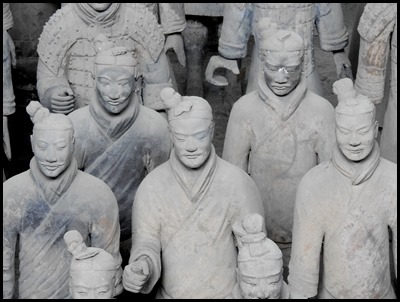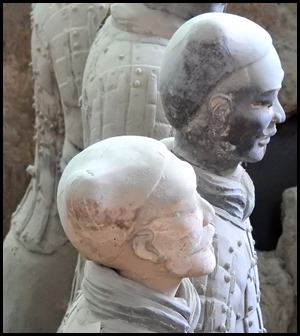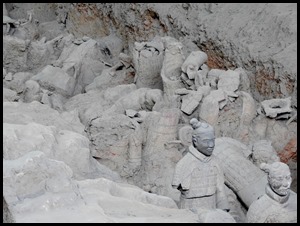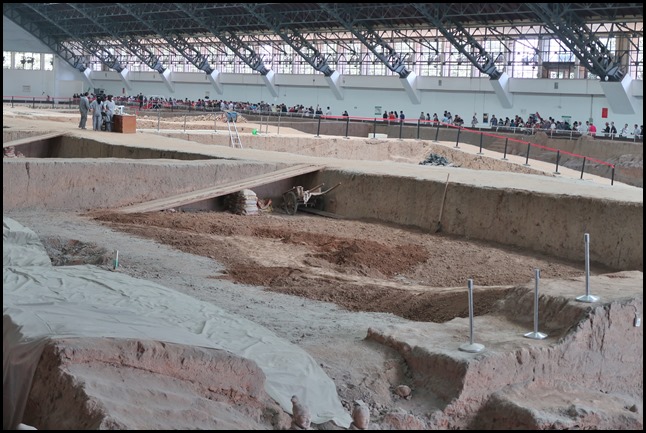TA Pit 1

|
Terracotta Army Pit
1
  We jumped out of the golf buggy that took
us from the entrance to the stop at the main area of this vast museum site. Pit 1 here we
come.
 We bimbled in, excitement building, went
up the steps and saw a crowd about five deep - moving after taking their
photographs. We waited our turn, keeping at bay those who may have wanted to
push in – using our size as a preventative measure........ We simply had to have
a Birthday Boy picture of him standing in the centre, the Terracotta Army below. So
Vast. Utterly unbelievable.
 We move to the far left corner to take in
the sheer size and in many ways the beautiful building that
protects the Terracotta Army from weather damage. Pit 1 is the largest of the three pits. It measures 230 metres long
from east to west, 62 metres wide from north to south, covering an area of
14,260 square metres. Up to now, about 2,000 pottery warriors and horses, 20
wooden chariots have been unearthed within an area of 4,000 square metres. It is
assumed that more than 6,000 terracotta warriors and horses, and 50 chariots
were buried in Pit 1.
 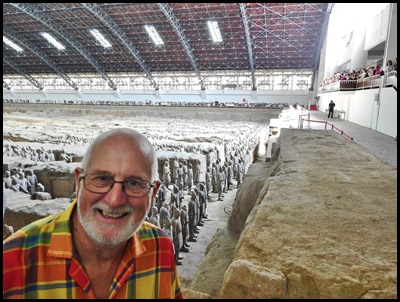 In March 1974, when local farmers were drilling a well in search of water, some pottery fragments were discovered here. In fact, amongst the bits and bobs found were some heads, so life-like that the drillers were frightened but word quickly spread about lifelike terracotta warriors and lots of bronze artifacts, buried for over two thousand years. The site of the well is literally behind Bear’s left elbow. Pit 1 was opened to the public on the
1st of October 1979 and is the largest pit, inside there are over 6,000
terracotta warriors and horses including infantry, cavalry and chariot warriors.
They are life-sized and arranged in a battle formation. In 1976, after careful
excavations of the Terracotta Army a large arched hall with an area of sixteen
thousand square metres was built above the pit to protect this precious army.
 A quarter of the way along on the left
side, we stopped to take in the size of the
‘shed’.
 The central part of Pit 1 is the main force of the army made up of thirty-six warrior columns - one hundred and seventy-eight metres long. Fifty battle chariots and four thousand infantry standing in military formation. Some warriors wear robes, some are in armour depending on their rank or army service. Meanwhile, each battle chariot is manned by three warriors, one to drive and two on guard, weapons in hand. Infantry in the two wings of Pit 1 held position to prevent the enemy from attacking the main troop.
Plan of Pit 1 showing only the right-hand end is occupied by the restored statues. The rest is used as a workroom where the statues are being restored (Illustration from “Dreams – the Qin Dynasty Terracotta Army of Dreams” by the Xi’an Press..
Up at the front is the vanguard of the army which stood in three arrow-shaped formation with two hundred and four warriors. These warriors are light infantry that all wear robes with girded leather belt and light shoes. Most of them are carrying quivers on their backs with arrow in hand, some of them held spears. At the two ends of the vanguard, wearing unique cloth and very different from the others, is the commander of this troop.
The Construction of Pit 1: Pit 1 is a subterranean earth-and-wood structure. Eleven corridors, divided by ten earth-rammed partition walls, are paved with pottery bricks on which the figures were placed.
The earth walls sustained wood roof that was composed of huge and strong rafters. The roof was covered with layers of fibre mats on which fine soil was filled. There are five sloping entrances on the four sides of the pit respectively, which were for constructing the pit in the Qin period. Once the construction of the pit was complete, the entrances were sealed with wooden pillars. It is known that upon ascending the throne at the age of thirteen, in 246 BC, Emperor Qin Shi Huang ordered the construction of this magnificent project, it is thought to have taken about thirty-eight years to complete. Although there is written history, no one survived the build as secrets had to be kept. Simply put - work on the project, don’t survive the project. It is thought that any worker at the end was killed to ensure the secrets. Some years ago forty-five graves were
uncovered within a few kilometres of the Emperor’s tomb, the International
Business Times reported, “skeletal remains of people believed to have
been buried in a coffin with their leg twisted.” This is one clue that these
crypts are connected to the terracotta warriors—“twisting leg of the dead before
burying was a burial custom of the Qin Dynasty,” say the
IBT. According to archaeologists, the number of pottery objects imprinted with the Li moniker that were unearthed in past years show that the township was large and important, with its major purpose being the building and protecting of Emperor Qin Shi Huang’s final resting place. The people whose remains were found in the 45 tombs would represent only a small fraction of the estimated 700,000 strong work force believed to have been recruited to work on the emperor’s mausoleum. The emperor’s tomb itself, reported to contain numerous precious stones and rivers of mercury, has still not been excavated.
Restored chaps and ‘work in progress’.
All the pottery warriors and horses were made using local clay, then baked in the kiln. After firing the figures were completed with painted detail. The Qin Terra-cotta Warriors and Horses were exquisitely made with ancient technology. The whole ‘thing’ is amazing but what we found particularly amazing is that each and every face was different, it was not as if they had ten moulds and repeated them hundreds of times, each warriors is an individual. We saw beards, moustaches, queues and bald heads, simple hats and fancy headpieces, semi-smiles and sternness – just extraordinary.
Half way along.
‘A day at the office’. How tiny the desk looks in the bottom picture.
A trusty steed.

So much more to be done as we take our final look at this incredible place.
ALL IN ALL DOCUMENTARIES DO NOT DO THIS JUSTICE
VAST, SO MUCH BIGGER THAN
ANTICIPATED |







